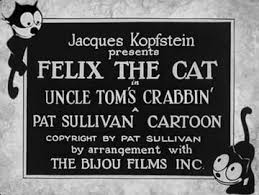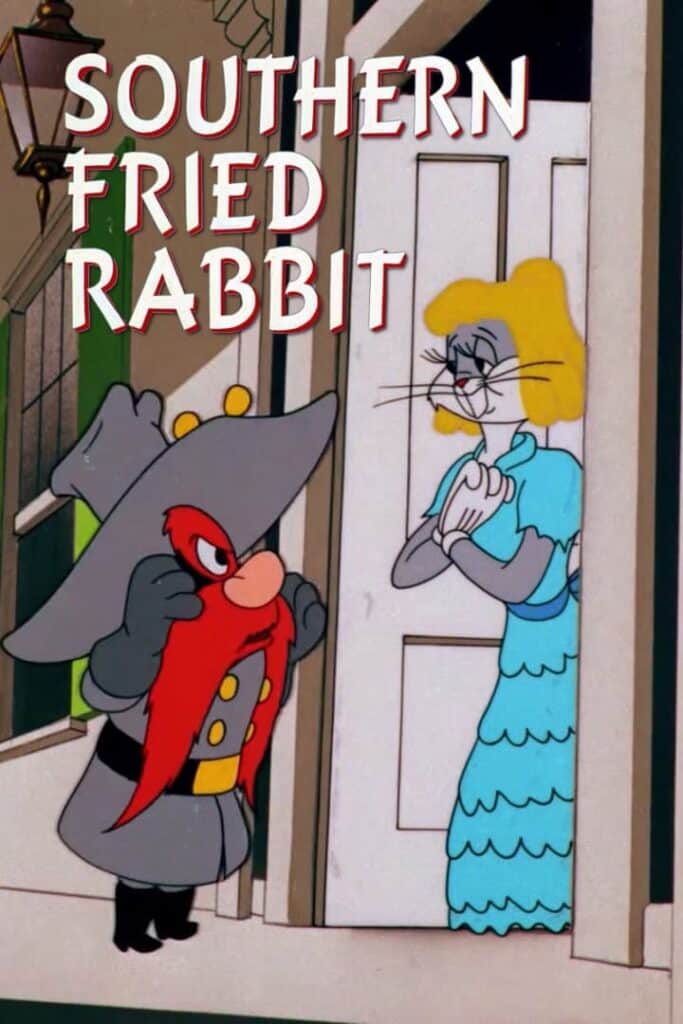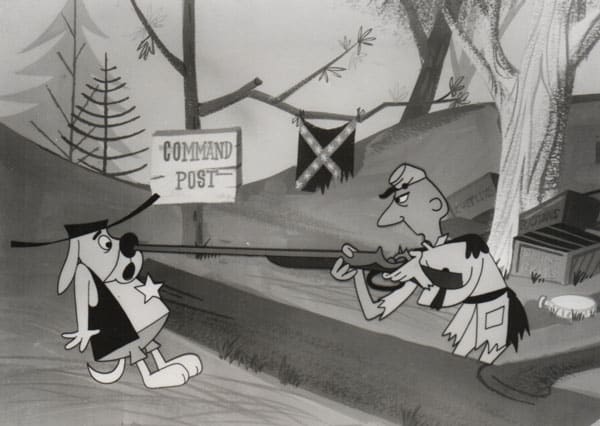The Civil War Comes to Toon Town
ECW welcomes back guest author Tom Elmore.
From the 1920s until the 1960s, the Civil War era was a popular subject for cartoons. Though animation legends worked on some, most contain examples of negative racial stereotyping.
African-Americans characters are portrayed as having big lips and ears, and sometimes resembling monkeys. The males are shown talking in deep, slow voices so as to sound unintelligent. Southern White males, meanwhile, are stereotyped as plantation owners wearing white tails, wide brim hats, having white mustaches and goatees, and a deep accent. Also, Dixie is almost always sung or used as background music.
Harriett Beecher Stowe’s Uncle Tom’s Cabin was a popular subject for animators. Instead of the tragic tone of the novel, viewers were “treated” to images of happy slaves, with the sadistic plantation owner Simon LeGree depicted as devilish looking.
Walt Disney was the first to spoof the novel in 1925’s Alice Stage Struck, a part of his Alice in Cartoonland series. Inspired by Alice in Wonderland, the Alice shorts combined a live action “Alice” with animation. In this short, while rehearsing a play, Alice is knocked unconscious and dreams she is running for her life on an ice floe from a bear who looks like Simon LeGree who wants to repossess her cabin.[1]
The next year Dinky Doodle in Uncle Tom’s Cabin by Walter Lantz was released. The Dinky Doodle series, like the Alice series, combined animation and live action except Dinky was animated, often interacting with Lantz. Again, the producing of a play is the film’s story.[2]

One of the first major “stars” of animation was in 1927’s Felix the Cat in Uncle Tom’s Crabbin. Felix travels from the frozen North to the Deep South where the land and weather is inviting. He hears a banjo being played by Uncle Tom and starts dancing to the music. Unfortunately, the music wakes up Simon LeGree who smashes the banjo and warns Uncle Tom not to wake him again. Using a frying pan and his own whiskers, Felix makes a new banjo, which wakes up LeGree and soon a chase ensues between the two, ending in Felix back in the wintery North.[3]
In the 1930s, New York City’s Van Beuren Studios produced a pair of shorts based on Uncle Tom’s Cabin. According to film historian Leonard Maltin, “none of the lead animators could draw terribly well, much less animate…they weren’t artists by any stretch of the imagination and it showed in their films.” This was apparent in their Uncle Tom cartoons which are among the most racist cartoons ever made.[4]
The 1930 short Dixie Days, later re-released as Uncle Tom & Little Eva, was the first sound cartoon based on Uncle Tom’s Cabin, and is arguably the worst ever spoof of the novel. Happy, singing, dancing African Americans are seen sprouting from watermelons, while slaves tap-dance on the auction block.[5]
In 1932 Van Bueren went back to Stowe’s novel with Down in Dixie which recycled animation from Dixie Days. Uncle Tom, Topsy, and Eliza run so far north they reach the North Pole where a walrus saves them from Simon LeGree. Afterwards, they board a boat and sing Dixie.[6]
Warner Bros. released Hittin’ the Trail for Hallelujah Land in 1931. In this riverboat melodrama “Piggy,” a cross between Porky Pig and Mickey Mouse, saves Uncle Tom from drowning and Eliza from Simon LeGree.[7]
In 1933 Disney released Mickey’s Mellerdrammer where Mickey and Minnie stage a production of Uncle Tom’s Cabin with disastrous results. Mickey plays Uncle Tom and Topsy. To create his “blackface” Mickey smokes an exploding cigar.[8]
Warner Bros. 1937’s Uncle Tom’s Bungalow, directed by Tex Avery, is famous for the line uttered by Uncle Tom to Simon LeGree, “My body belongs to you, but my soul belongs to Warner Brothers.” [9]
Terrytoons also released two versions of the tale. 1938’s Eliza Runs Again, a jazz- themed adaptation of the novel, is considered lost, though some animation may have been reused in 1944’s Eliza on the Ice. In the latter, Eliza and her baby meet LeGree at a “starting line” for a race where Uncle Tom is the starter. The two then engage in a wild chase with Mighty Mouse saving the day after getting a call from Heaven.[10]
Stowe’s novel was also spoofed in the Warner Bros. cartoons Have You Got Any Castles? (1938), Trap Happy Porky (1945), and Book Revue (1946).[11]
In Metro-Goldwyn-Mayer’s (MGM) 1947 Uncle Tom’s Cabana, Uncle Tom tells some children a tall tale about how he saved his cabin from Simon LeGreedy by turning it into a Cabana with Little Eva as the star. When LeGreedy goes after Little Eva, he and Uncle Tom battle it out. Avery directed this film and, his villain’s devilish pointed ear appearance is similar to the one he used in Uncle Tom’s Bungalow ten years earlier.[12]
Little Eva is played by “Red,” a sultry redheaded female character that appeared in seven of Avery’s MGM cartoons, which the studio claimed were their most successful shorts. Though Cabana has some funny moments, what might have been a great cartoon is ruined by the negative stereotype depictions of Uncle Tom and the children.[13]
In Warner Brothers’ 1949’s Mississippi Hare, Bugs Bunny is a stowaway on a Mississippi riverboat where he tangles with Col. Shuffle, an exceedingly polite, but deceitful card player. During their battle on the boat, Bugs lures the colonel into seeing a production of Uncle Tom’s Cabinet.[14]
Civil War soldiers and veterans appear in several cartoons. The first was Columbia Pictures 1932 Soldier Old Man. The popular comic strip character, Krazy Kat, is working in an old soldier’s home when the veterans start demanding food, resulting in a bizarre food fight.[15]
Warner Bros. poked fun at Gone With the Wind in Have You Got Any Castles? In 1939’s The Film Fan featured a faux movie trailer for Gone With the Breeze, “the story of a ding-dong-daddy and his Southern belle.” But it was not until 1940’s Confederate Honey that the novel received a full-scale satire. Elmer Fudd played Captain Nett Cutler who woes Crimson O’Hairoil.[16]
That same year MGM released Tom Turkey and His Harmonica Humdingers in which a group of harmonica playing turkeys, one of whom is a Confederate veteran, literally brings down a store’s roof with their music, which included “Dixie.”[17]

Warner Bros. 1953’s Southern Fried Rabbit has Bugs Bunny going to Alabama, which has a record carrot crop. Confederate Yosemite Sam, who thinks the war is not over, stops him at the Mason-Dixon line.[18]
In this cartoon the South is shown as Eden, while the North is a barren wasteland. Bugs disguises himself as General Brickwall Jackson and Abraham Lincoln. In the latter disguise Bugs tells Sam to “look me up at my Gettysburg address.” In the end, Sam is tricked into going to Chattanooga where the New York Yankees are in town. A scene with Bugs in blackface keeps Southern Fried Rabbit off television.[19]
Walt Disney made several live-action films and television shows set during the Civil War. But after his two Uncle Tom’s Cabin satires he made only one cartoon related to the war, 1954’s Grand Canyonscope, the first animated film shot in wide screen Cinemascope process. In it Donald Duck wanders in the Grand Canyon and meets a mountain lion. When Donald reads in his guidebook that there have been no lions in the canyon since the Civil War, the lion dons a kepi. A chase ensues between the lion and Donald throughout the canyon, resulting in the canyon being filled in.[20]
In the 1957 Droopy cartoon Blackboard Jumble, a laid-back wolf with a Southern drawl, wearing a Confederate kepi, takes over a classroom. For a finger painting exercise he tells the students to paint a Confederate flag. When he notices no stars on the flag, he is hit on his head and stars move from his skull to the flag.[21]
In 1961’s Rebel Without Claws, Confederate courier Tweety Bird is trying to get a message to Gen. Robert E. Lee. Opposing him is “Messenger Destroyer” Sylvester Cat, leading Tweety to say “I tawt I taw a damn Yankee tat.” Military gags ensue and for once Sylvester actually captures Tweety.[22]

Terrytoon’s Deputy Dawg found himself fighting the war in 1962’s Rebel Trouble. The slow witted canine deputy and a Confederate veteran stumble upon actors playing Union soldiers and assume the war is back on and proceed to re-fight it.[23]
Poor financial returns forced many animation studios to close in the 1960s. Production costs for an MGM cartoon 1963 was $42,000 ($460,000 today.) When Walter Lantz closed his studio, it was taking ten years for his shorts to recover their production costs.[24]
However, the war has been spoofed in a number of television cartoon series. Among the more popular is Bullwinkle‘s Whatsamatta U story line (1964) in which Confederate Army battle plans are substituted for the Whatsamatta U football team’s stolen game plans, with the South winning.[25]
Other animation series with Civil War based-episodes include South Park’s The Red Badge of Gayness (1999) about a re-enactment gone amok and Family Guy’s To Love and Die in Dixie where the Griffin family is relocated by the Witness Protection Program to the Southern town of Bumblescum, where the residents think the South won the Civil War.[26]
Since their debut in 1969, the Scooby-Doo gang has worked on at least six mysteries with a Civil War tie-in. It has also been revealed that Scooby-Doo himself has a Civil War ancestor.[27]
Many of the cartoons mentioned here have never been shown on television, in part due to the negative stereotypes displayed in them. (Some Tom & Jerry cartoons were reanimated and redubbed to change an African-American maid into an Irish one before airing them on T.V.) A few have been released on home media with disclaimers, while some public domain examples can be found on the internet and in bargain bin DVDs. While these cartoons are generally offensive, examining them can teach us much about how people have viewed the war and African-Americans over time.[28]
Tom Elmore holds a B.A. in History and Political Science from the University of South Carolina. He has written and lectured on classic Hollywood cinema and collects cartoons from animation’s golden age and books about it. The synopsis and reviews of the cartoons featured in this article are from his own personal viewings of them.
Endnotes:
[1] Maltin, Leonard, Of Mice and Magic-A History of American Animated Cartoons. New York, Plume Books.1980, Pgs. 30-32, Webb, Graham, The Animated Film Encyclopedia. Jefferson, N.C., McFarland & Company. 2000. Pgs. 14-15
[2] Maltin, Pgs. 160-161, Webb, Pg. 118
[3] Maltin, Pgs. 23-26, Webb, Pg. 156
[4] Maltin, Pgs. 200.
[5] Webb, Pg. 119
[6] Ibid, Pg. 129
[7] Maltin, Pg.226, Webb, Pg. 222
[8] Webb, Pg. 311
[9] Ibid, Pg. 510
[10] Ibid, Pgs. 138, Beck, Jerry, Lost Terrytoon, Cartoon Research, May 31, 2021. Cartoonresearch.com/index.php/lost-terrytoons, Maltin, Pg.384, 386. Some animation from Eliza Runs Again may have also been reused in 1941’s Mississippi Swing.
[11] Webb. Pgs. 211, 500, 57
[12] Canemaker, John, Tex Avery-The MGM Years, 1942-1955. Atlanta, Ga. Turner Publishing, 1996 Pgs. 98, 102-106.
[13] Ibid, Pgs. 32-33, Maltin, Pgs. 292-295. “Red” was the inspiration for Jessica Rabbit.
[14] Adamson, Joe, Bugs Bunny-Fifty Years and Only One Grey Hare. New York. Henry Holt and Company. 1990. Pg. 179
[15] Webb, Pg.457
[16] Ibid, Pg. 211, 160, 101-102
[17] Ibid, Pg. 294
[18] Adamson, Pg. 182
[19] Ibid
[20] Webb, Pg. 197
[21] Ibid, Pgs. 50-51
[22] Ibid, Pg. 413
[23] Ibid, Pgs. 413 This is a sequel to 1962’s made for television cartoon, Rabid Rebel, where Deputy Dawg tries to convince a Confederate soldier the war is over
[24] Maltin, Pgs. 307, 186. In the 1960s $1.5 million was the average production cost for a full-length movie.
[25] Scott, Keith, The Moose That Roared. New York. St. Martin’s Press.2000.Pgs.378-379
[26] Internet Movie Data Base (IMDB) South Park The Red Badge of Gayness, www.imdb.com/title/tt0763052/, IMDB. Family Guy, To Love and Die in Dixie, www.imdb.com/title/0576976/
[27] scoobydoo.fandom.com/wiki/
[28] Maltin, Pg. 308 Many World War II era cartoons are also banned from television due to their racist portrayals of the Japaneese.
Can’t believe you failed to mention Foghorn Leghorn!
An interesting and thought provoking entry. Thank you. Although the author ends on a somewhat ambivalent note: “While these cartoons are generally offensive, examining them can teach us much about how people have viewed the war and African-Americans over time.”
So do we cancel, delete, erase, or tear down things modern culture finds “generally offensive”? Or do we engage thoughtfully, discuss, debate, disagree, and see what they “can teach us”?
“The Simpsons…”